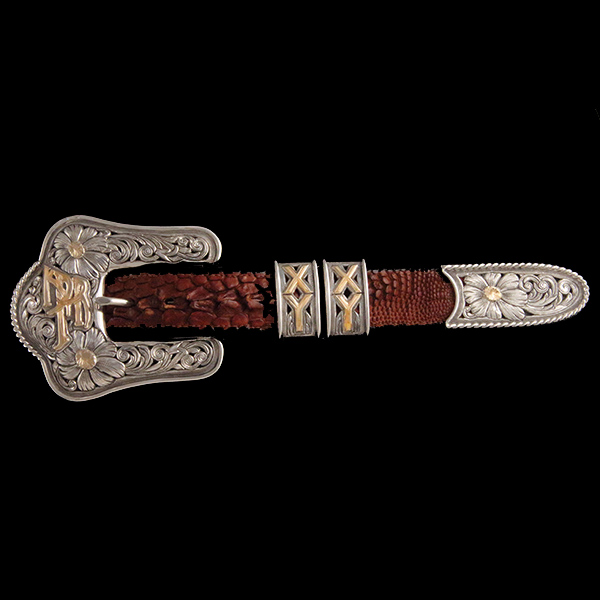
At home on the range in Calgary, Alberta, rancher and master jeweler Scott Hardy derives his designs from the fortitude of cowboys and the vast beauty of the West.
This story begins during the gold rush in the hub of San Francisco, when craftsmen traded in their tools for sifting pans in search of a fortune that was rarely found. When all hope of a golden future was shattered and the tools were dusted off and resharpened, these craftsmen returned to their roots. Earning a wage meant long hours and manual work, but this time it was rewarding. They went back to welding metal and making saddles using skills passed down through generations, from relatives in Mexico, South America, and Europe. New appreciation for materials sourced from the animals and natural resources from Western lands led to the rise of ranches and the cowboys who tended them.
Horsing Around
“For me, it was a long journey,” Scott says. He fondly recalls his youth living in a small town, working as a fifth-generation stockman and a mountain guide for outfitters, all the while planning his future as a cattle rancher and dreaming of building his own empire. However, it was an ad for a local jewelry-making class and a nudge from his young wife, Leslie, that led to his transition from shoeing horses to silversmithing. He says, “When I got working with silver and felt the way it could move, and saw some of the possibilities you could do with it, it just kinda stole my heart.”
Fortunate Findings
At first, Scott wanted to create anything and everything that showed his respect for and pride in Western traditions. “I can’t tell you how many times I have wandered around my shop thinking, ‘How can I do this?’ ” he says. After training under several craftsmen, including silversmith Mark Drain and saddlemaker Chuck Stormes, Scott forged his own path as a Western silversmith—discovering the way silver visually and texturally displays the heritage of cowboy culture.
Making a Mark
Today, it is hard to imagine the master as an apprentice. Scott’s filigree and engraving of Western belt buckles, hollowware, saddle horns, and stirrups capture lifelike movement and invoke sentiment in a way few others in his craft have perfected. A founding and current member of the Traditional Cowboy Arts Association (TCAA), Scott is the first silversmith to have his work featured on a Canadian stamp. His coveted designs are showcased in museums and sought after by private collectors and celebrities such as Garth Brooks and Andre Agassi.
Scott is constantly pushing his design boundaries, incorporating different metals and bench techniques to achieve an elevated level of jewelry design—something demanded by the TCAA. Each year, members are required to present a minimum of three Western pieces that outshine the work they displayed the year before. Scott credits much of his skill to this Western exhibition, hosted by the National Cowboy & Western Heritage Museum in Oklahoma City. His most recent designs include a Child’s Set, Saddle Silver, Cuff Bracelet, Flask and Shot Glass Set, and many buckles.
“A buckle, it’s kinda a funny thing,” Scott says. “If you’re in a room with a bunch of Westerners, you’ll notice each person checking out the other person’s waistline!” Scott believes the goal of designing belt buckles is to lose ownership of the piece as an artist as quickly as possible. He feels successful when the buckle’s artwork, monogram, and brand create an heirloom rather than a collector’s item. “It’s a huge part of the cowboy’s culture and identity, the buckle. I love creating all kinds of things, but the buckle is the most special piece that I create. It’s a way to take a little piece of the West with you, no matter where you go.”
Teaching Tradition
It’s as much about the future as it is about the past in Western culture. But knowing where you come from is extremely important to carrying on tradition as a Western artisan. “The West never stops. The West is always growing and changing. I want to honor the past but celebrate the future,” Scott says.
Scott does this through the mentorship program he created with the TCAA. Members are dedicated to teaching the trade and continuing its traditions. Up-and-coming Western artists like Jodi Brown and Tanner Crow have been granted fellowships through the TCAA to study under the masters—an opportunity Scott wishes was around when he started out. His advice to all aspiring artists? “Never quit. Never give up. Live your passion. You don’t create great works by not having passion. Period.”
The story continues. Even after 40 years of silversmithing, Scott has no plans to retire. “I always tell everybody I signed up for the ‘thump method,’ ” he says with a laugh. “When my head hits the bench and goes, ‘Thump!’ I’m done.”